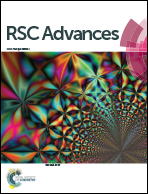Anomalous electrical properties of poly vinyl alcohol films with Tb3+ ions and copper nanoparticles in different solvents
Abstract
Laser ablation was used to fabricate copper nanoparticles (NPs) in different solvents from sodium lauryl sulphate, acetone and ethanol by applying 1064 nm radiation from a Nd:YAG laser. The sizes and shapes of the colloidal Cu NPs were investigated by transmission electron microscopy (TEM). The electrical conductivities of Tb3+ in polymer films with Cu NPs were measured in the frequency range of 20 Hz to 1 MHz and the temperature range of 308–343 K. It was found that the electrical conductivity of Tb3+ was greater for larger Cu NPs with sizes ranging from 20–40 nm in ethanol as compared to Cu NPs with smaller dimensions formed in the other two solvents. It was concluded that using ethanol as the solvent enhanced the electrical conductivity of Tb3+ in the polymer film. The activation energy as well as the variation in the loss tangent with temperature also explains the enhanced electrical conductivity.


 Please wait while we load your content...
Please wait while we load your content...